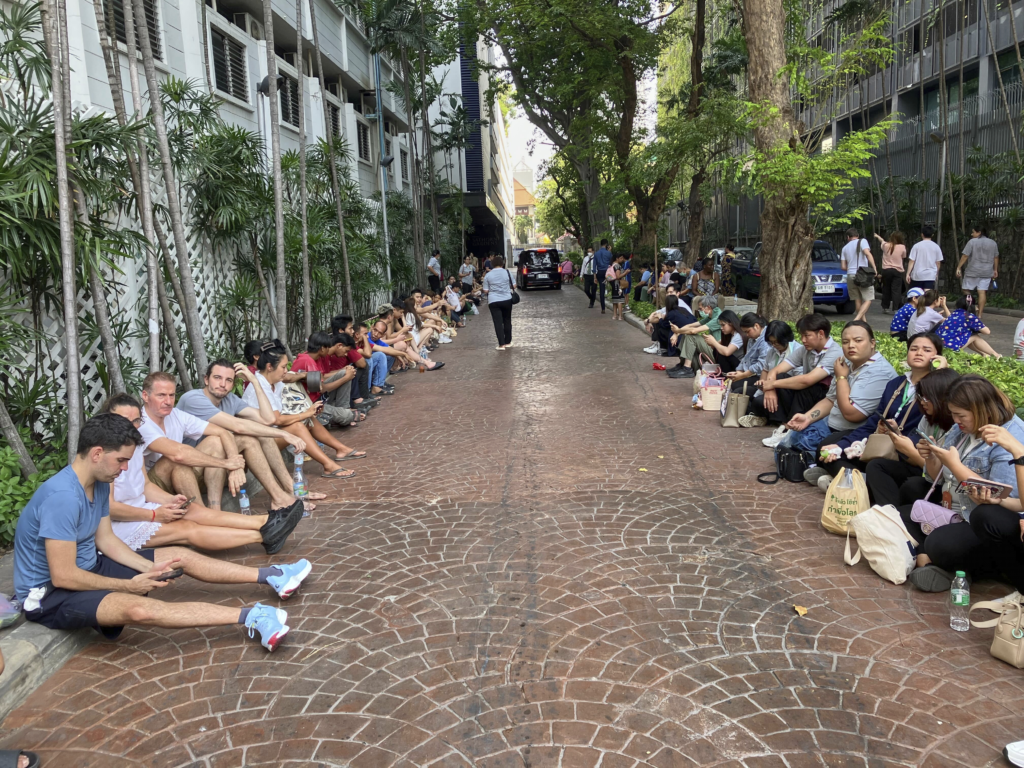BANGKOK, THAILAND – March 29, 2025 — In an unexpected and alarming turn of events, a magnitude 5.6 earthquake struck Bangkok early Saturday morning, sending tremors across the capital and sparking widespread concern among residents. The quake, which occurred at approximately 6:42 AM local time, jolted people awake and triggered a wave of reactions both offline and on social media, with many sharing videos and firsthand accounts of the frightening experience.

According to preliminary data from the United States Geological Survey (USGS) and Thailand’s Meteorological Department (TMD), the epicenter was located about 130 kilometers northwest of Bangkok, at a depth of 10 kilometers, a relatively shallow quake for the region. While Bangkok is not typically associated with high seismic activity, this latest event has raised fresh concerns about the city’s preparedness for earthquakes, especially in densely populated urban zones.
Local Impact: Shaken but Standing
The areas most affected included Nonthaburi, Pathum Thani, and central Bangkok, where residents reported moderate to strong shaking. While no fatalities have been reported so far, at least 27 people have been treated for minor injuries, primarily caused by falling debris and panic-induced incidents.
Some older buildings in the Dusit and Bang Rak districts suffered cosmetic damage—cracked walls, fallen ceiling tiles, and broken glass were reported in both residential and commercial properties. Evacuations were briefly ordered at several high-rise condominiums and office towers, particularly along Sukhumvit Road, as a precautionary measure.
Infrastructure Vulnerability in a Growing Metropolis
Despite being Southeast Asia’s economic powerhouse, Bangkok’s infrastructure is not inherently designed to withstand strong seismic events. Experts have long warned that the city’s rapid vertical growth—particularly its high-rise boom over the past two decades—has outpaced earthquake-resilient planning.
“Many of Bangkok’s high-rises are built to wind-load standards, not seismic ones,” said Dr. Surachai Wongtan, a structural engineer with Chulalongkorn University. “While they may resist sway, they’re vulnerable to horizontal ground movement.”

Buildings constructed before the 2007 building code update, which began incorporating seismic considerations after the 2004 Indian Ocean tsunami and the 2014 Chiang Rai earthquake, are particularly at risk.
Social Media: A Real-Time Earthquake Diary
Within moments of the tremor, Thai Twitter (now X), TikTok, and Instagram exploded with updates using hashtags like #BangkokEarthquake and #ThailandEarthquake2025. Videos of swaying chandeliers, vibrating windows, and startled pets quickly went viral. One video, shot from a high-rise in Sathorn, showed water sloshing dramatically in a rooftop pool—a vivid testament to the quake’s power.
“It felt like the whole building was breathing,” one user wrote. “I’ve lived in Bangkok for 15 years and never felt anything like this.”
These online reactions not only showcased the fear and confusion experienced by locals but also highlighted the lack of a clear and timely public emergency alert during the event.
Emergency Response: Quick but Not Comprehensive
Thailand’s Disaster Prevention and Mitigation Department (DPMD) issued a brief statement within an hour of the quake, confirming the event and urging residents to remain calm. However, there was no automatic mobile alert system deployed, a shortcoming that has sparked criticism among citizens and urban planners alike.
First responders were dispatched to key affected zones by 7:15 AM, and mobile medical units were stationed near major intersections and transit hubs. By noon, authorities had completed inspections of all major transportation infrastructures, including BTS Skytrain lines and Suvarnabhumi Airport, with operations continuing without disruption.
Historical Context: A Rare But Growing Threat
While Bangkok is not typically considered earthquake-prone, the region has experienced indirect tremors from neighboring fault lines in Myanmar and northern Thailand. The most significant recent seismic event in the country was the 6.1-magnitude earthquake in Chiang Rai in 2014, which caused widespread damage and several injuries.
However, Saturday’s tremor is one of the strongest recorded in central Thailand in recent memory, raising questions about the broader Bangkok seismic activity profile and the nation’s preparedness strategy.
Economic and Travel Impacts
As Southeast Asia’s leading tourism and business hub, Bangkok’s vulnerability to natural disasters could have far-reaching implications. Several morning flights were temporarily delayed at both Don Mueang and Suvarnabhumi Airports, though normal operations resumed within hours.

Local businesses, particularly in tourist-heavy areas like Khao San Road and Silom, saw a dip in morning foot traffic, though no major closures were reported. Travel agencies have begun fielding inquiries from concerned travelers, especially those scheduled to stay in high-rise accommodations.
The Psychological Toll: Fear and Preparedness
Beyond physical damage, the quake left many residents grappling with anxiety and a sense of unpreparedness. Bangkokians, unaccustomed to seismic events, reported feelings of fear and helplessness, especially in households with children or elderly members.
“Everything shook, and I just froze,” said Supansa Kaewdee, a kindergarten teacher. “We learn about earthquakes in science class, but living through one is different. I realized I have no idea what to do.”
Mental health experts have begun issuing public advice on coping with disaster-related stress, while schools and workplaces are considering incorporating earthquake drills into their safety protocols.
Stay Informed and Connected
Authorities are urging the public to stay informed via the TMD and DPMD official channels. Residents are encouraged to check on loved ones, secure furniture in their homes, and stay clear of damaged buildings.
If you experienced the earthquake in Bangkok March 29, share your story in the comments below or tag us on social media. Your voice matters.